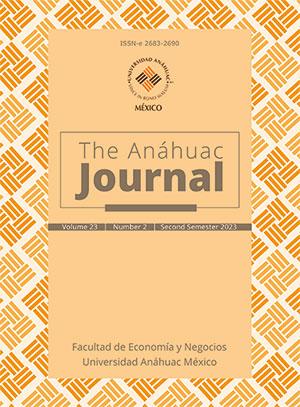The impact of VXY and EM-VXY on the implied volatility of ATM option premiums for the USD/MXN exchange rate on the CBOE
Contenido principal del artículo
Resumen
A series of econometric tests is proposed to study the impact of the VXY and EM-VXY indices on the implicit volatility of at-the-money options of the USD/MXN exchange rate and the premiums on their call and put options. The objective is to determine if these indicators can predict future changes in implied volatility and be used as entry or exit flags in investment and hedging strategies. Additionally, the volatility index (VIX), the USD/MXN exchange rate, and the Mexican Federal Treasury Certificates and London Interbank Offered Rate rates are included as complementary variables. Results show that although the EM-VXY, VIX, and the exchange rate are statistically significant for implicit volatility modeling, they do not have a predictive power that allows them to be used as entry or exit indicators. None of the variables are significant for modeling the premiums in call and put options. This research contributes to the filtering of instruments that, despite their design, may not contribute to the understanding of markets in emerging countries, such as Mexico. Future studies can extend this methodology to other exchange rates, trying different combinations of rates.
Downloads
Detalles del artículo
Sección

Esta obra está bajo una licencia internacional Creative Commons Atribución-NoComercial-CompartirIgual 4.0.
The Anáhuac Journal se distribuye bajo Licencia Creative Commons Atribución-NoComercial-CompartirIgual 4.0 Internacional.
Cómo citar
Referencias
Avendaño Cruz, S. & Mata Hernández, J.M. (2021). Pronóstico del tipo de cambio USD MXN durante el COVID-19 con métodos de suavización y descomposición. Revista Enfoques. Ciencia Política y Administración Pública, 19 (34), 1-15. http://www.revistaenfoques.cl/index.php/revista-uno/article/view/552
Banco de México (n.d.). Certificados de la Tesorería de la Federación. Secretaría de Hacienda y Crédito Público, Banco de México, 1-8. https://www.banxico.org.mx/mercados/d/%7B0DE0044F-662D-09D2-C8B3-4F1A8E43655F%7D.pdf
Black, F. & Scholes, M. (1973). The pricing of options and corporate liabilities. Journal of Political Economy, 81 (3), 637. https://doi.org/10.1086/260062
Bollerslev, T. (1986). Generalized autoregressive conditional heteroskedasticity. Journal of Econometrics, vol. 31 (3), 307-327. https://doi.org/10.1016/0304-4076(86)90063-1
Breusch, T.S. & Pagan, A.R. (1979). A simple test for heteroscedasticity and random coefficient variation. Econometrica, 47 (5), 1287–1294. https://doi.org/10.2307/1911963
D’Agostino, G., Di, E., Enrique F., Marques, S., Reif, S., & García, J.(2013). Volatilidad implícita en opciones. El rol de la fórmula de Black and Scholes y la posibilidad de cálculo sin asumir un modelo determinado. Revista de Investigación en Modelos Financieros, 1 (1). http://bibliotecadigital.econ.uba.ar/download/rimf/rimf_v1_n1_07. pdf
Engle, R.F. (1982). Autoregressive Conditional Heteroscedasticity with Estimates of the Variance of United Kingdom Inflation. Econometrica, 50 (4), 987-1007. https://doi.org/10.2307/1912773
Fassas, A.P. & Siriopoulos, C. (2021). Implied volatility indices - A review. Quarterly Review of Economics and Finance, 79, 303-329. https://doi.org/10.1016/j.qref.2020.07.004
Fleming, J., Ostdiek, B. & Whaley, R.E. (1995). Predicting stock market volatility: A new measure. Journal of Futures Markets, 15 (3), 265-302. https://doi.org/10.1002/fut.3990150303
ICE (2023) LIBOR, ICE Benchmark Administration. ICE NYSE. https://www.theice.com/iba/libor
İskenderoglu, O. & Akdag, S. (2020) Comparison of the effect of Vix fear index on stock exchange indices of developed and developing countries: The G20 case. South East European Journal of Economics and Business, 15 (2), 105-121. https://doi.org/10.2478/jeb-2020-0009
JP Morgan, Reuters, (1996) RiskMetrics-Technical Document. https://www.msci.com/documents/10199/5915b101-4206-4ba0-aee2-3449d5c7e95a
Latané, H.A. & Rendleman Jr., R.J. (1976). Standard deviations of stock price ratios implied in option prices. (Papers and Proceedings of the Thirty-Fourth Annual Meeting of the American Finance Association Dallas, Texas December 28-30, 1975) The Journal of Finance, 31 (2), 369-381. https://doi.org/10.2307/2326608
Liao, S., Chen, J. & Ni, H. (2021). Forex trading volatility prediction using Neural Network Models. arXiv:2112.01166 [q-fin.ST], 1-21. https://doi.org/10.48550/arXiv.2112.01166
Lorenzo Alegría, R.M. (1996). La volatilidad: modelización en la valoración de opciones y estimadores. Investigaciones Europeas de Dirección y Economía de la Empresa, 2 (1), 59-83. https://dialnet.unirioja.es/servlet/articulo?codigo=187716
Mushtaq, R. (2011). Testing time series data for stationarity. http://dx.doi.org/10.2139/ssrn.1911068
Normand, J. & Sandilya, A. (2006). Introducing the JPMorgan VXY & EM-VXY. JPMorgan.
Olden, J.D. & Jackson, D.A. (2002). Illuminating the “black box”: A randomization approach for understanding variable contributions in artificial neural networks. Ecological Modelling, 154 (1/2), 135-150. https://doi.org/10.1016/S0304-3800(02)00064-9
Pilbeam, K. & Langeland, K.N. (2015). Forecasting exchange rate volatility: GARCH models versus implied volatility forecasts. International Economics and Economic Policy, 12 (1), 127-142. https://doi.org/10.1007/s10368-014-0289-4
Roberts, S.W. (2000). Control Chart Tests Based on Geometric Moving Averages. Technometrics, 42 (1), 97-101. https://doi.org/10.1080/00401706.2000.10485986
Solís, S. & Muñoz, L. (2019). Volatilidad del tipo de cambio en México: ¿Síntoma de la enfermedad holandesa? Gestión y estrategia, 55, 75-89. https://doi.org/10.24275/uam/azc/dcsh/gye/2019n55/Solis
Whaley, R.E. (2009). Understanding the VIX. Journal of Portfolio Management, 35 (3), 98-106. https://doi.org/10.3905/JPM.2009.35.3.098
White, K.J. (1992). The Durbin-Watson Test for Autocorrelation in Nonlinear Models. The Review of Economics and Statistics, 74 (2), 370-373. https://doi.org/10.2307/2109675

